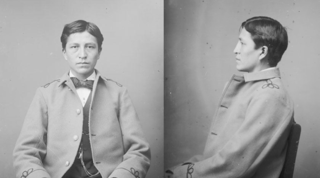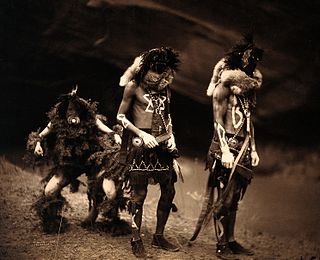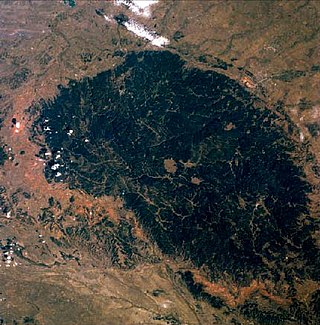
The Lakota are a Native American people. Also known as the Teton Sioux, they are one of the three prominent subcultures of the Sioux people, with the Eastern Dakota (Santee) and Western Dakota (Wičhíyena). Their current lands are in North and South Dakota. They speak Lakȟótiyapi—the Lakota language, the westernmost of three closely related languages that belong to the Siouan language family.

Devils Tower is a butte, possibly laccolithic, composed of igneous rock in the Bear Lodge Ranger District of the Black Hills, near Hulett and Sundance in Crook County, northeastern Wyoming, above the Belle Fourche River. It rises 1,267 feet (386 m) above the Belle Fourche River, standing 867 feet (264 m) from summit to base. The summit is 5,112 feet (1,558 m) above sea level.

The Wintu are Native Americans who live in what is now Northern California. They are part of a loose association of peoples known collectively as the Wintun. There are four major groups that make up the Wintu people. There northern Wintun (Wintu) and the Central Wintun (Namlaki) are most common. Others are the Nomlaki and the Patwin. The Wintu language is part of the Penutian language family but there are different dialects. Before the European colonization, different Wintun communities interacted with each other but were more inclined to communicate with others tribes to the east and west.

Black Elk Peak is the highest natural point in the U.S. state of South Dakota and the Midwestern United States. It lies in the Black Elk Wilderness area, in southern Pennington County, in the Black Hills National Forest. The peak lies 3.7 mi (6.0 km) west-southwest of Mount Rushmore. At 7,244 feet (2,208 m), it is the highest summit in the United States east of the Rocky Mountains. Though part of the North American Cordillera, it is generally considered to be geologically separate from the Rocky Mountains.

An American Indian reservation is an area of land held and governed by a U.S. federal government-recognized Native American tribal nation, whose government is sovereign, subject to regulations passed by the United States Congress and administered by the United States Bureau of Indian Affairs, and not to the U.S. state government in which it is located. Some of the country's 574 federally recognized tribes govern more than one of the 326 Indian reservations in the United States, while some share reservations, and others have no reservation at all. Historical piecemeal land allocations under the Dawes Act facilitated sales to non–Native Americans, resulting in some reservations becoming severely fragmented, with pieces of tribal and privately held land being treated as separate enclaves. This jumble of private and public real estate creates significant administrative, political, and legal difficulties.

Bear Butte is a geological laccolith feature located near Sturgis, South Dakota, United States, that was established as a State Park in 1961. An important landmark and religious site for the Plains Indians tribes long before Europeans reached South Dakota, Bear Butte is called Matȟó Pahá, or Bear Mountain, by the Lakota, or Sioux. To the Cheyenne, it is known as Noahȧ-vose or Náhkȯhe-vose, and is the place where Ma'heo'o imparted to Sweet Medicine, a Cheyenne prophet, the knowledge from which the Cheyenne derive their religious, political, social, and economic customs.

The Winnemem Wintu are a Native American band of the Wintu tribe originally located along the lower McCloud River, above Shasta Dam near Redding, California.

The Sun Dance is a ceremony practiced by some Native Americans in the United States and Indigenous peoples in Canada, primarily those of the Plains cultures. It usually involves the community gathering together to pray for healing. Individuals make personal sacrifices on behalf of the community.

Suzan Shown Harjo is an advocate for Native American rights. She is a poet, writer, lecturer, curator, and policy advocate who has helped Native peoples recover more than one million acres (4,000 km²) of tribal lands. After co-producing the first American Indian news show in the nation for WBAI radio while living in New York City, and producing other shows and theater, in 1974 she moved to Washington, D.C., to work on national policy issues. She served as Congressional liaison for Indian affairs in the President Jimmy Carter administration and later as president of the National Council of American Indians.

The American Indian Religious Freedom Act, Public Law No. 95–341, 92 Stat. 469, codified at 42 U.S.C. § 1996, is a United States federal law, enacted by joint resolution of the Congress in 1978. Prior to the act, many aspects of Native American religions and sacred ceremonies had been prohibited by law.

Luther Standing Bear was a Sicangu and Oglala Lakota author, educator, philosopher, and actor. He worked to preserve Lakota culture and sovereignty, and was at the forefront of a Progressive movement to change government policy toward Native Americans.

The Lower Brulé Indian Reservation is an Indian reservation that belongs to the Lower Brulé Lakota Tribe. It is located on the west bank of the Missouri River in Lyman and Stanley counties in central South Dakota in the United States. It is adjacent to the Crow Creek Indian Reservation on the east bank of the river. The Kul Wicasa Oyate, the Lower Brulé Sioux, are members of the Sicangu, one of the bands of the Lakota Tribe. Tribal headquarters is in Lower Brule.

Native American religions are the spiritual practices of the Native Americans in the United States. Ceremonial ways can vary widely and are based on the differing histories and beliefs of individual nations, tribes and bands. Early European explorers describe individual Native American tribes and even small bands as each having their own religious practices. Theology may be monotheistic, polytheistic, henotheistic, animistic, shamanistic, pantheistic or any combination thereof, among others. Traditional beliefs are usually passed down in the forms of oral histories, stories, allegories, and principles.

The Black Hills is an isolated mountain range rising from the Great Plains of North America in western South Dakota and extending into Wyoming, United States. Black Elk Peak, which rises to 7,244 feet (2,208 m), is the range's highest summit. The Black Hills encompass the Black Hills National Forest. The name of the hills in Lakota is Pahá Sápa. The Black Hills are considered a holy site. The hills are so called because of their dark appearance from a distance, as they are covered in evergreen trees.
The Association on American Indian Affairs is a nonprofit human rights charity located in Rockville, Maryland. Founded in 1922, it is dedicated to protecting the rights of Native Americans.

The United States government illegally seized the Black Hills – a mountain range in the US states of South Dakota and Wyoming – from the Sioux Nation in 1876. The land was pledged to the Sioux Nation in the Treaty of Fort Laramie, but a few years later the United States illegally seized the land and nullified the treaty with the Indian Appropriations Bill of 1876, without the tribe's consent. That bill "denied the Sioux all further appropriation and treaty-guaranteed annuities" until they gave up the Black Hills. A Supreme Court case was ruled in favor of the Sioux in 1980. As of 2011, the court's award was worth over $1 billion, but the Sioux have outstanding issues with the ruling and have not collected the funds.
Lyng v. Northwest Indian Cemetery Protective Association, 485 U.S. 439 (1988), was a United States Supreme Court landmark case in which the Court ruled on the applicability of the Free Exercise Clause to the practice of religion on Native American sacred lands, specifically in the Chimney Rock area of the Six Rivers National Forest in California. This area, also known as the High Country, was used by the Yurok, Karuk, and Tolowa tribes as a religious site.
Christopher (Toby) McLeod is the project director of Earth Island Institute's Sacred Land Film Project, which he founded in 1984 as one of Earth Island's original projects. Since 2006 he has been producing and directing the four-part documentary film series Standing on Sacred Ground, which premiered in 2013 at the Mill Valley Film Festival and aired nationally on PBS in 2015. Standing on Sacred Ground features eight indigenous communities around the world fighting to protect their sacred places. The award-winning series visits Altaians in Russia, the Winnemem Wintu in northern California, Papua New Guinea, the tar sands of Canada, the Gamo Highlands of Ethiopia, Peru, Australia and Hawaii. McLeod produced and directed the award-winning documentary In the Light of Reverence (2001) and has made three other award-winning documentary films: The Four Corners: A National Sacrifice Area? (1983) with Glenn Switkes and Randy Hayes,. Downwind/Downstream (1988) with Robert Lewis, and NOVA: Poison in the Rockies (1990). His first film was the 9-minute short The Cracking of Glen Canyon Damn—with Edward Abbey and Earth First! (1982) with Glenn Switkes and Randy Hayes. The focus of these educational projects has been to increase public awareness and understanding of sacred natural sites, indigenous peoples' cultural practices and worldviews, and environmental justice.

The Recognition of Native American sacred sites in the United States could be described as "specific, discrete, narrowly delineated location on Federal land that is identified by an Indian tribe, or Indian individual determined to be an appropriately authoritative representative of an Indian religion, as sacred by virtue of its established religious significance to, or ceremonial use by, an Indian religion". The sacred places are believed to "have their own 'spiritual properties and significance'". Ultimately, Indigenous peoples who practice their religion at a particular site, they hold a special and sacred attachment to that land sacred land.
















